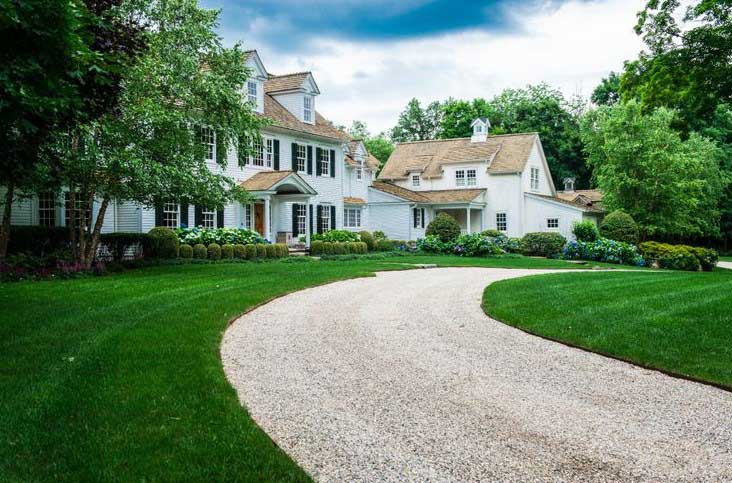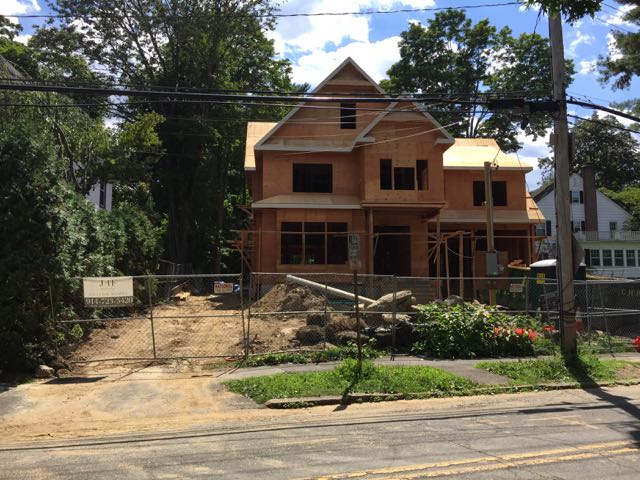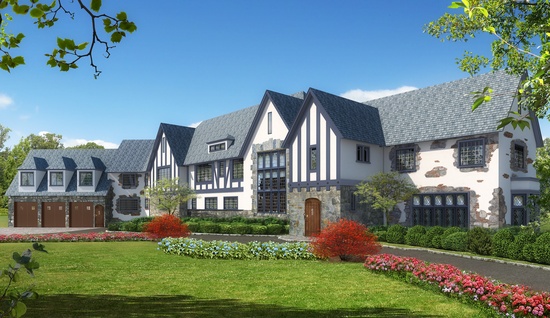Builders, Real Estate Agents and Large Property Owners Contest Law To Limit Lot Coverage
- Wednesday, 23 September 2015 13:57
- Last Updated: Thursday, 24 September 2015 07:25
- Published: Wednesday, 23 September 2015 13:57
- Joanne Wallenstein
- Hits: 15184
 An attempt by the Scarsdale Board of Trustees to limit the size of homes in the Village met resistance from builders, real estate agents and owners of homes on multi-acre lots at a hearing on proposed new village zoning code on September 21.
An attempt by the Scarsdale Board of Trustees to limit the size of homes in the Village met resistance from builders, real estate agents and owners of homes on multi-acre lots at a hearing on proposed new village zoning code on September 21.
The revision calls for gravel surfaces to be treated as impervious and thereby included in lot coverage calculations. This would mean that gravel driveways and pathways would count as asphalt surfaces and limit the size of homes or other accessory structures on a lot.
Trustees originally passed a moratorium on counting gravel as pervious in February 2015 after they received widespread complaints about teardowns and the construction of new homes that dwarfed neighboring properties, blocked light and air and appeared to be too large for their lots. Unable to find an easy fix to the Floor Area Ratio (FAR) provisions that would address these issues, they passed the moratorium to allow for time to study it. It was subsequently extended until October 2015. The new gravel definition would also address an inconsistency in Village Code whereby gravel surfaces are treated as impervious for storm water management purposes but pervious when calculating lot coverage.
However, the residents who originally spurred the moratorium were no where to be seen on Monday night when Village Hall was filled with angry developers, their lawyers, real estate agents and owners of large properties who voiced their objections to what they believe is a limitation of their rights as property owners.
Before they took the microphone, Trustee and Deputy Mayor David Lee, who heads the Village Law and Land Use Committee, asked a consultant from Frederick P. Clark Associates to present a summary of her findings on the use of gravel surfaces. She explained that her group examined 5,026 residential lots and determined that 504 parcels had gravel driveways. They found that that though 10% of existing homes have gravel driveways, 25% of the recent applications (within the past two years) utilized gravel surfaces to exceed lot coverage regulations. She concluded that if the law stays as is, open space will decrease as more projects exceed lot coverage regulations.
The consultants recommended that the Village eliminate the discrepancy between the storm water and zoning code definitions of gravel and revise code to treat gravel as an impervious surface. They also recommended that all homes with gravel surfaces now be grandfathered.
Benefits to the change would include:
- Protection of open space by limiting increased development on residential lots
- Correction of the inconsistency of the definition of gravel
- Treatment of gravel will be consistent with NYSDEC regulations
- A Grandfather clause to provide relief to non-conforming lots
The builders, attorney's and residents who voiced their objections questioned every aspect of the consultant's study, her findings, the legal basis of the code revision and even the competency of the Trustees and Village Planner. They spared no words in attacking the proposal and the people behind it.
Landscaper Elaine Yellen asked if the engineering department had looked beyond driveways at the use of gravel in backyards. She said, "I do care about stewardship of the environment but this law takes away people rights unnecessarily. She said that gravel is permeable, and the substructure underneath it could be permeable too, "If there is a problem it is not the gravel, it is what's underneath it." She continued, "I don't use it to increase lot coverage and I use it to solve drainage problems and it's baffling that there is the perception that gravel impedes drainage." She concluded with, "If it seems to me that if the houses are too big let's change the far or bulk codes. Leave my precious gravel alone."
Raif Ezratty of Garden Road said, "I don't see why we are confusing storm water and lot coverage. Peoples' rights are being taken away. It is affecting the larger lots that have plenty of grass and have very long driveways.
The storm water drainage systems that people are putting in, store water and then empty into the village's storm water system. We passed laws that were not thought out. If the town is concerned about water they should limit people's basements. The bill would affect home values and take away tax revenues."
Attorney John Orsini spoke on behalf of his client Bala Real Estate Holdings who owns a flag lot at 15B Cushman Road. He explained that his client was concerned that the long driveway leading to the flag lot would count as lot coverage but that after a meeting with the Village Planner and Village Attorney he found that this will not be the issue for flag lots. Even though the law did not pose a problem for his client, he went on to argue against it sayings, "Why are we talking about the definition of impervious? If the board thinks there should be less coverage there should be straightforward amendments.... this is confusing ..."
 Lynne Clark, a resident of 13 Walworth Avenue and a realtor with Houlihan Lawrence said, "I care about Scarsdale a lot. It appears that the main intent is to limit and reduce lot coverage to limit the size of construction. But it will also limit other homes from adding a family room or a two car garage. I do not believe this as prudent as rethinking the FAR.
Lynne Clark, a resident of 13 Walworth Avenue and a realtor with Houlihan Lawrence said, "I care about Scarsdale a lot. It appears that the main intent is to limit and reduce lot coverage to limit the size of construction. But it will also limit other homes from adding a family room or a two car garage. I do not believe this as prudent as rethinking the FAR.
My comments apply to existing homes. There will be unintended consequences such as:
- Infringement of property rights
- Increased request for variances
- Increased burden of applications for building department
Permits are now taking 6 weeks. It will take even longer. There will be more teardowns because you wont be able to modify what is there. I think we will have more applications for new construction. There will be delays in making a sale because of uncertainty. There will be delays to get on the agenda of the zoning board of appeals. A buyer will move onto another less complicated opportunity."
I have an old house. The house badly needs a family room. I am afraid the new law won't allow it. You need to think about these consequences
Elana Ezratty, also of 97 Garden Road said "Oversized new homes do not have gravel driveways. This law will impact the larger properties. Many of the large homes have large gravel driveways and as the property grows you have less room to work with. Pools and pool houses are behind homes and are not the point of the law. This will mean that all the people who now have gravel can pave the driveway and it
will result in less permeable not more permeable surfaces."
Jeremy Gans of 45 Harvest Drive said, " This is my third time before the board. Though you must balance development with maintaining the community, this does nothing to maintain it. It reduces property values and is environmentally and scientifically unwise. The intent is to reduce bulk, maintain neighborhood character and adequate light and air. If I had drafted this I would have been dismissed from my law firm. It does not address the concerns. Amend the section of code limiting the size of homes on the lots. I have only heard one person speak in favor of it. Given substantial opposition, let the moratorium lapse. Over a year has been devoted to this issue."
 In an effort to demonstrate the pervious nature of gravel, builder David Fenton brought a glass pitcher which he had lined with paper towels and filled with gravel. He poured the liquid over the gravel and watched it fall onto the paper towel. At this point, Mayor Jon Mark asked, "Is that how a driveway would be installed?"
In an effort to demonstrate the pervious nature of gravel, builder David Fenton brought a glass pitcher which he had lined with paper towels and filled with gravel. He poured the liquid over the gravel and watched it fall onto the paper towel. At this point, Mayor Jon Mark asked, "Is that how a driveway would be installed?"
Fenton said, "We have a problem! There are great builders in this community!
It is difficult for us to move forward during this moratorium. We are handicapped because of this situation. When you look at sales, it has almost been at a stand still. There are a lot of gray areas. We can't get things approved. This is impacting sales."
At this point, Trustee Bill Stern asked Fenton, "How do these large homes impact smaller homes? How do you think the McMansions affect the smaller homes on the block?"
Steve Rakoff introduced himself as a builder, family man and a realtor since 1989. He said, "People who have larger homes will have to move their homes forward. We are investors in the future viability of our village. Ultimately it's not about what we want, our customers are telling us what they want – a fire pit, an exercise room. This will impact a sale and they will go to other places."
He continued, "FP Clark only looked at 5,000 homes out of 5,900. We did our own study of one neighborhood (Murray Hill) and found that 44% contain gravel driveways. We cannot put a bullet to our heads. For high-end homes this would be the second step in unfairly penalizing 1+ acre lots. I have not had problem with storm water. Listen to the applicants that are investing in these properties." He then presented charts showing the allowable lot coverage on properties with one to six acres to demonstrate that as lot sizes get larger allowable coverage is not increased proportionately.
Lawyer Lawrence Graham said he was representing clients on Sherbrooke and Heathcote Roads. He said, "All of my properties are in excess of 3 acres. We are grappling with the driveway and getting to the garage. These homes are unnecessarily penalized. Additionally acreage is not rewarded with additional lot coverage."
Shawn Singer of 70 Penn Boulevard said, "My ninth grade daughter says gravel is a rock we find in nature. We spent money for this survey and all we got are 3-4 slides. We don't have the numbers. It's a waste our taxpayer dollars. Let's discuss FAR, not gravel."
Dawn Knief, an agent at Julia B Fee in Scarsdale said she just moved out of town. She read an extensive letter from her client Melinda Witmer of Whig Road. Witmer said, "I installed extensive water retention program at my house ...Gravel is permeable...
I addressed drainage by installing a drainage system ....It's ridiculous to maintain the character this way."
Knief continued, "We've had zero showings on high end properties because of high taxes. People are choosing not to come here. It used to be almost a right of passage to move to Scarsdale to put children into our schools. Now our taxes are so high. We're not allowing them to come in and build and put in a pool. I am very concerned!"
Mark Koch of Birchall Drive said, "My house will become non-conforming. Sales are being impacted and future buyers will be impeded. Gravel was the mainstay of a system that the town embraced."
Builder Bobby Ben Simon of 11 Seneca Road said, "This committee and the planning board should come clean. Do you want to attack houses, fine! You are trying to change engineering. Concentrate on what you are trying to achieve. You cannot have it both ways."
Turning to the consultant's report, Ben Simon charged, " This is some piece of work!
Why take only two years, why not five, why not ten! 2% of construction is new over the last 2 years. You missed a great opportunity ..... you wasted six months .... you did not hold a hearing ....it is a mediocre report. Maybe 4 years in college was a waste of time!"
He continued, "I built more than half of the houses on Seneca Road. The fight on large homes came to a halt. You maxed out on the FAR rules. We get it. You want small houses, find the right way to do it."
Developer Paul Fontana credited the previous speakers with raising many of the points he was going to make and added, "It's just going to limit our ability to build pools and tennis courts – it won't make homes smaller."
George Stone told the trustees, "This will change the aesthetics. We used gravel to set our homes back on the property. This is disproportionately against the larger homes. We are using the wrong tools. There will be unintended consequences on value. This creates uncertainty. We can't calculate this easily and it will put an undue burden on administrative staff. You're creating a much bigger problem that you can't solve."
Former Trustee Bob Harrison urged the board to "Change the height requirements.
Change the FAR. You've come a long way. The consultant put a lot of time in – of course she got paid! It won't harm our community if you don't pass this legislation."
Lena Crandall put in a plea for the Village to "Protect the village's tree canopy and maintain and increase the green infrastructure. She said, "Renovate in a considerate way. We need our trees."
Ron Parlato, from the Heathcote Association said there are deed restrictions on the 38 homes in the Association and asked Planned Liz Marrinan if she had looked into how this new law would impact those deeds. He said, "I have a 9,000 square foot house on 2 acres with another structure. This means I can't put a pool on my property."
John Brandt said, "I have lived here a long time. We heard many well-spoken people speak reasonably. Reconsider the approach you are taking ...go the FAR route. There is uncertainty in the market and the moratorium should be lifted. I don't think the direction is a good one."
At the conclusion of the meeting Mayor Jon Mark thanked the group for coming to the meeting and said a vote on the proposed law would not be held that night. He announced that the Board of Trustees will meet at 8 am on Wednesday September 30 to discuss the matter further and to vote. The complete meeting can be viewed here.







